Can Chickens And Turkeys Live Together?
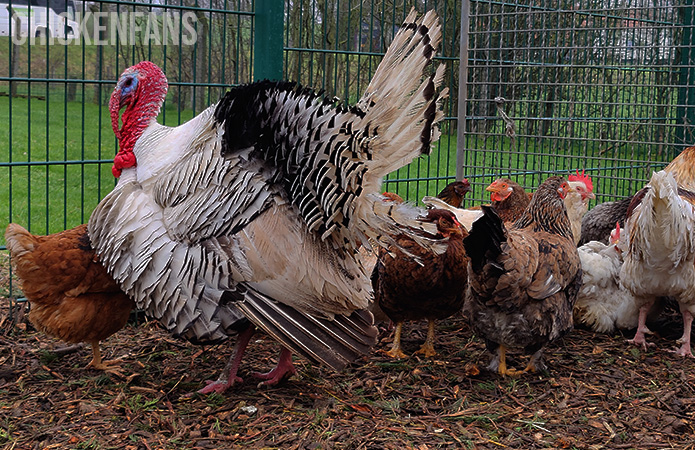
Whether you prefer clucks or gobbles, chickens and turkeys are among the most popular backyard poultry in the world. But can these two beauties be kept under the same roof? Let’s address the unexpected difficulties and possible benefits of housing chickens and turkeys together.
Can Chickens and Turkeys be Kept in the Same Space?
Raising chickens and turkeys together is possible, as many experienced poultry keepers can attest. However, most veterinarians don’t recommend it. That’s because, despite being birds, both species have vastly different needs and behaviors.
For example, you can’t feed both chickens and turkeys the same type of feed because they have different diets. They also can’t communicate well with each other because they each have different ways of expressing themselves. This can also lead to bullying in some cases.
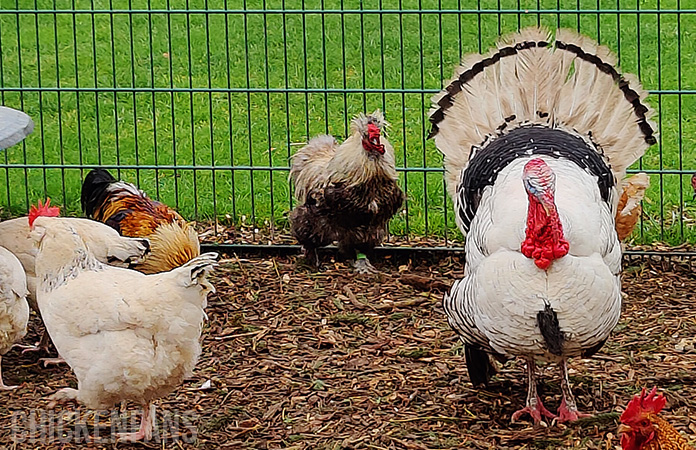
Before you start raising chickens and turkeys together in the same backyard, you need to address some common issues first to avoid problems down the line.
Common issues are:
- Behavior and Pecking Order
- Nutritional Needs
- Housing Space
- Diseases
Behavior and Pecking Order
Regarding temperament, both chickens and turkeys have different general moods. Chickens are noisier, display an in-your-face attitude, and are flighty. Whereas turkeys are more calm, peaceful and display a pacifist attitude.
As such, there are plenty of situations where bullying occurs, with chickens acting as the primary aggressor early in their lives. However, if both sides are properly introduced to each other, you can avoid this issue. In some cases, turkeys can even act as peacemakers between two fighting chickens.
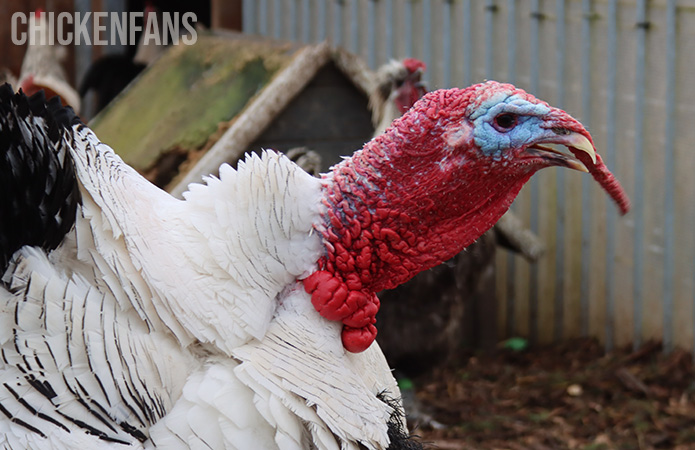
When roosters get too aggressive with turkey hens, the male turkeys retaliate and act as guardians. Turkeys can kill chickens when things go too far. Always be on the lookout for such behavior.
Miscommunication is another reason why bullying occurs between chickens and turkeys. Chickens and turkeys use different ways to communicate and express themselves.
For one, chickens communicate with a variety of loud noises. From clucking to cackling to squawking, chickens display various noises to get their thoughts across to the entire flock.
On the other hand, turkeys prefer to communicate with each other using low-frequency sounds that are difficult for the human ear to pick up. They also use their feathers, especially the males, to relay their thoughts to others. The distinct gobbling sound turkeys make is mainly used to attract females.
Nutritional Needs
When raising chickens and turkeys for commercial and meat purposes, you can’t feed them the same feed. It can drastically ruin their value.
Raising turkeys meant for the dinner table requires a high-protein diet. However, feeding chickens the same diet will greatly affect their meat and egg production.
Egg-laying hens need more than protein if you want them to keep producing eggs with sturdy shells throughout the year. They also need plenty of calcium to form strong egg shells.
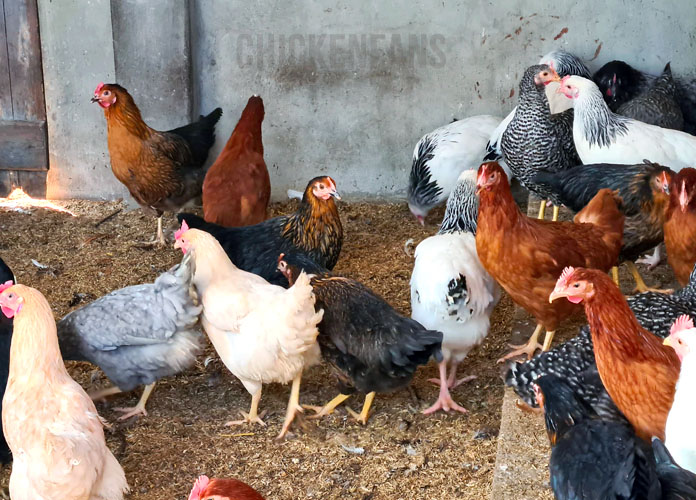
Most common chicken breeds grow absurdly fast on a protein-rich diet. Feeding them turkey feed will exceed the recommended amount, leading to certain health issues like kidney failure.
If you’re keeping turkeys as nothing more than a pet or a backyard companion, you can feed them the same type of feed you give your chickens. However, it’s recommended not to feed them layer feed but instead use a feed source suited for mixed flocks, like a flock raiser or an all-flock feed.
Housing Space
Both chickens and turkeys need ample room to roam around or free-range. A lack of space can lead to bullying and other unwanted behavior. This is especially prevalent during mealtime.
Chickens need a minimum of 10 square feet per bird. Turkeys, however, need more than double that amount, as they need at least 25 square feet per bird.
However, you don’t need to set up a high fence for either. Erecting a fence at least four feet high is enough to keep your birds from flying away to your neighbor’s backyard.
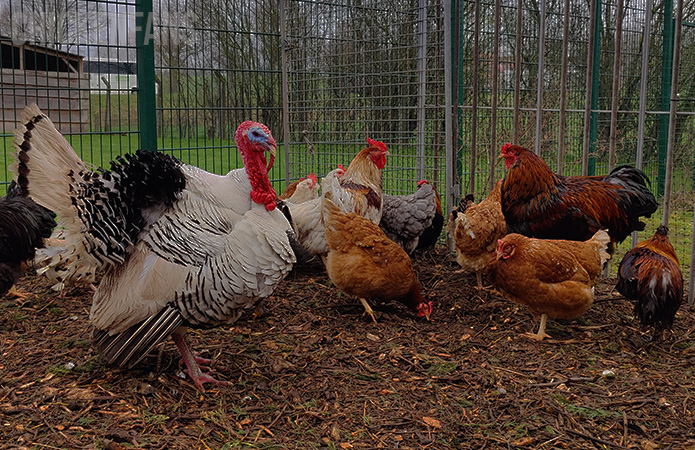
However, you do need to provide enough space for all the birds to perch. Chickens don’t generally need a large area, but turkeys do by default because they are generally larger than their counterparts. You will need different roosts for chickens and turkeys, and let them choose which one they prefer.
Providing enough space for both species allows them to feel relaxed and safe. It also prevents unwanted accidents and injuries that can lead to death in the flock.
If you want to know the minimum requirements for a coop and run for your chicken flock, including the number of nesting boxes to provide, try out our ‘Coop Size Calculator’.
Diseases
When raising two different species in the same backyard, diseases are always at the forefront of the discussion. And when it comes to keeping chickens and turkeys, ‘Histomoniasis’ is something all backyard keepers think about.
Histomoniasis, also referred to as “blackhead disease”, is a deadly poultry disease that affects chickens, turkeys, peacocks, ducks, game fowls, and others. A protozoan by the name of Histomonas meleagridis causes this disease. It spreads from bird to bird within a flock via their droppings.
Chickens are much more tolerant of this disease than turkeys. As such, chickens can act as carriers of this disease, which spells disaster for any turkeys you own or plan to own.
Blackhead disease targets a bird’s liver and intestines, specifically the cecum. This causes inflammation in the infected areas, which then leads to ulcers. Blackhead disease is lethal in most cases.
Some symptoms an infected bird can exhibit are messy feathers, lethargicness, and yellow droppings. Young birds usually die within a few days after exhibiting symptoms, while older birds experience a slower death through emaciation.
An infected turkey flock experiences a 70–100 percent mortality rate. The disease is less severe in chickens, but it can still lead to poor overall health and a decline in egg production.
Treatment for Blackhead Disease
The only FDA-approved drug to combat this disease is Histostat, an arsenic-based animal drug. However, the company stopped producing the drug due to high levels of inorganic arsenic in birds, asking the FDA to withdraw the drug’s approval.
To completely remove the disease, you must eliminate your entire infected and non-infected flock. Then you must wait at least three years for the parasite that causes the disease to die out. Even then, it’s not a foolproof solution.
How to Keep Chickens and Turkeys Healthy Together?
There are plenty of things that you need to remember if you want both chickens and turkeys to get along well and live a healthy life together in your backyard. One thing that beginners tend to forget is that both species need the company of the same species.
Chickens are the more social species between the two and enjoy the company of a large flock. Turkeys need at least one companion to keep them happy and emotionally stable.
If you plan to introduce turkeys to your flock of chickens, be aware of potential diseases the two could share. Blackhead disease needs to be at the top of your priority list. Quarantine new birds at least two weeks before introducing them to the flock.
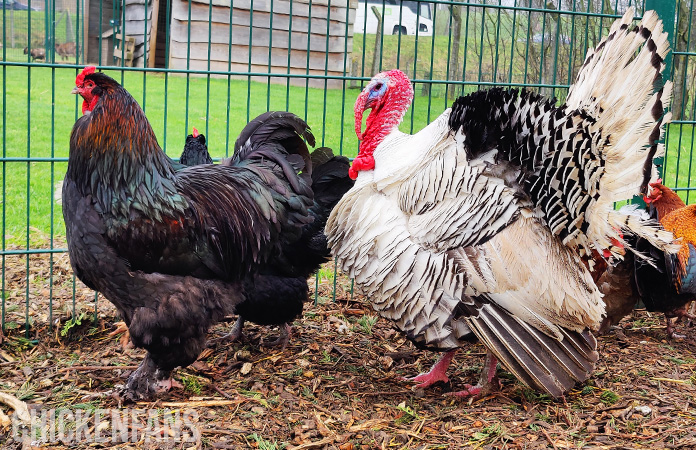
Can Chickens Hatch Turkey Eggs and Vice Versa?
Chickens and turkeys can hatch each other’s eggs because the eggs of both species incubate at roughly the same temperature, 99 degrees Fahrenheit. But the time each hen needs to sit on the eggs differs. Chicken eggs require around 21 days to hatch, while turkey eggs take considerably longer at 28 days.
However, letting turkey hens hatch chicken eggs carries more risk than the reverse, because turkey hens are bigger and can trample or even break chicken eggs.
Can Chicks And Poults Live Together?
While the adults of both birds can learn to coexist with one another, the same is not true for their offspring. Experienced chicken keepers recommend that you keep both poults and chicks apart. This is to prevent the latter from bullying the former.
Both chicks and poults exhibit the same behavior as their adult counterparts. The only difference is that an adult turkey can better fend for itself because of its larger size than an adult chicken.
When raising chicks and poults, keeping them separate while they’re young is best. Once they grow into their adult sizes, you can introduce them to one another as long as the conditions for healthy and safe cohabitation are met.
Summary
While most veterinarians do not recommend that you raise both chickens and turkeys together in the same backyard, experienced chicken keepers beg to differ. As long as you meet all the conditions to ensure that both birds can get enough nutrition, living space, a sleeping area, and health care, raising chickens and turkeys together is possible.
Blackhead disease is the only issue that you need to worry about. If you prevent this disease from spreading throughout the flock, you’re good to go when raising both birds together.
If you want to learn more about co-housing multiple poultry types together, take a look at our ‘Can chickens live with guinea fowl‘ and ‘Can chickens and ducks live together‘ articles.



















